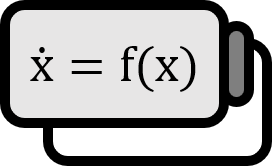Strange Attractor
Definition
Chaos 1
A closed set that is invariant and topologically transitive is called an attractor. A compact invariant set that is sensitive to initial conditions and topologically transitive is referred to as chaotic. A chaotic attractor is known as a strange attractor.
Sensitive Dependence on Initial Conditions 2
Consider a dynamical system in a metric space $\left( X, d \right)$ defined by a differential equation as shown in $\dot{x} = f(x)$. $$ d ' \left( A , x \right) := \inf \left\{ d (a, x) : a \in A \right\} $$ Define the distance $d ' \left( A, x \right)$ between a set $A$ and a point $x$ as shown above. An attractor $A$ is a set that satisfies the following three properties:
- $A$ is an invariant set.
- If $x (0) \in U$ then $t \to \infty$, such that, there exists an open set $U$ containing $A$.
- There does not exist a subset of $A$, satisfying the two conditions above, that is a proper subset.
An attractor exhibits sensitivity to initial conditions if it is called a strange attractor.
Homoclinic Orbit 3
Let the flow at a given time $t$ in a system be represented as $\phi_{t}$. A closed invariant set $A$ is called indecomposable if there exist $t_{1} , \cdots t_{n} > 1$ such that for every pair $(x, y) \in A$ and $\varepsilon > 0$, the distance between $\phi_{t_{k}} \left( x_{k-1} \right)$ and $x_{k-1}$ becomes smaller than $\varepsilon$. $$ x = x_{0} , x_{1}, \cdots , x_{n} = y $$
An indecomposable closed invariant set $A$ is called an attractor if there exists an open set $U$, containing points that are $\varepsilon$ distance away from $A$ at given $\varepsilon > 0$, and if $x \in U$, the omega limit set of $x$ is contained in $A$. An attractor accommodating transverse homoclinic orbits is termed a strange attractor.
Fractal 4
Let the flow at a given time $t$ in a system be represented as $\phi_{t}$. An invariant set $A$ is called stable if it satisfies the following two conditions:
- For every sufficiently small neighborhood $U \supset A$, there exists a neighborhood $V \supset A$ such that for all $x \in V$ and $t > 0$, it becomes $\phi_{t} (x) \in U$.
- For every $x \in U_{0}$, when $t \to \infty$, there exists a neighborhood $U_{0} \supset A$ of $A$ such that it is $\phi_{t} (x) \to A$.
An invariant fractal set is termed a strange attractor if it is stable.
Differentiability 5
An attractor is defined as the omega limit set of almost all initial conditions in the neighborhood of a compact set. An attractor that is not a finite set and is not piecewise differentiable is called a strange attractor.
Explanation
In Korean, it is also referred to as 예측할 수 없는 끌개 or “unpredictable attractor”.
The purpose of introducing so many definitions is to convey that the concept of a strange attractor can be viewed from various perspectives and does not lead to a clear consensus.
For a simple intuition, the Lorenz attractor is a familiar example, and within the context of chaos theory, the term strange attractor is often regarded almost equivalently to chaos, as repeatedly mentioned in the definitions.
However, scholars like Celso and others in their paper highlight that the term chaotic refers to the dynamics of the attractor, while strange refers to the geometric structure of an attractor5. Indeed, they have suggested that strange attractors are closely related to fractals and non-differentiability6. In their paper, they demonstrated the existence of specific examples of strange yet non-chaotic attractors, suggesting that it is challenging to assert what a strange attractor is purely based on chaos or sensitivity to initial conditions.
Wiggins. (2003). Introduction to Applied Nonlinear Dynamical Systems and Chaos Second Edition(2nd Edition): p740. ↩︎
Strogatz. (2015). Nonlinear Dynamics And Chaos: With Applications To Physics, Biology, Chemistry, And Engineering(2nd Edition): p324~325. ↩︎
Guckenheimer. (1983). Nonlinear Oscillations, Dynamical Systems, and Bifurcations of Vector Fields: p237, 256. ↩︎
Kuznetsov. (1998). Elements of Applied Bifurcation Theory: p16~18. ↩︎
Grebogi, C., Ott, E., Pelikan, S., & Yorke, J. A. (1984). Strange attractors that are not chaotic. Physica D: Nonlinear Phenomena, 13(1-2), 261-268. https://doi.org/10.1016/0167-2789(84)90282-3 ↩︎ ↩︎
Ruelle, D., Takens, F. On the nature of turbulence. Commun.Math. Phys. 20, 167–192 (1971). https://doi.org/10.1007/BF01646553 ↩︎
